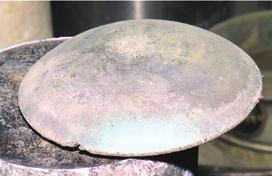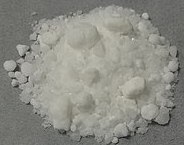
Nitrogen is a chemical element; it has symbol N and atomic number 7. Nitrogen is a nonmetal and the lightest member of group 15 of the periodic table, often called the pnictogens. It is a common element in the universe, estimated at seventh in total abundance in the Milky Way and the Solar System. At standard temperature and pressure, two atoms of the element bond to form N2, a colorless and odorless diatomic gas. N2 forms about 78% of Earth's atmosphere, making it the most abundant uncombined element in air. Because of the volatility of nitrogen compounds, nitrogen is relatively rare in the solid parts of the Earth.

In chemistry, a salt or ionic compound is a chemical compound consisting of an ionic assembly of positively charged cations and negatively charged anions, which results in a neutral compound with no net electric charge. The constituent ions are held together by electrostatic forces termed ionic bonds.

In an aqueous solution, precipitation is the process of transforming a dissolved substance into an insoluble solid from a supersaturated solution. The solid formed is called the precipitate. In case of an inorganic chemical reaction leading to precipitation, the chemical reagent causing the solid to form is called the precipitant.

An ionic liquid (IL) is a salt in the liquid state at ambient conditions. In some contexts, the term has been restricted to salts whose melting point is below a specific temperature, such as 100 °C (212 °F). While ordinary liquids such as water and gasoline are predominantly made of electrically neutral molecules, ionic liquids are largely made of ions. These substances are variously called liquid electrolytes, ionic melts, ionic fluids, fused salts, liquid salts, or ionic glasses.
1-Butyl-3-methylimidazolium tetrachloroferrate is a magnetic ionic liquid. It can be obtained from 1-butyl-3-methylimidazolium chloride and ferric chloride. It has quite low water solubility.

Liquid–liquid extraction, also known as solvent extraction and partitioning, is a method to separate compounds or metal complexes, based on their relative solubilities in two different immiscible liquids, usually water (polar) and an organic solvent (non-polar). There is a net transfer of one or more species from one liquid into another liquid phase, generally from aqueous to organic. The transfer is driven by chemical potential, i.e. once the transfer is complete, the overall system of chemical components that make up the solutes and the solvents are in a more stable configuration. The solvent that is enriched in solute(s) is called extract. The feed solution that is depleted in solute(s) is called the raffinate. Liquid-liquid extraction is a basic technique in chemical laboratories, where it is performed using a variety of apparatus, from separatory funnels to countercurrent distribution equipment called as mixer settlers. This type of process is commonly performed after a chemical reaction as part of the work-up, often including an acidic work-up.

1-Butyl-3-methylimidazolium hexafluorophosphate, also known as BMIM-PF6, is a viscous, colourless, hydrophobic and non-water-soluble ionic liquid with a melting point of -8 °C. Together with 1-butyl-3-methylimidazolium tetrafluoroborate, BMIM-BF4, it is one of the most widely studied ionic liquids. It is known to very slowly decompose in the presence of water.
A multiphasic liquid is a mixture consisting of more than two immiscible liquid phases. Biphasic mixtures consisting of two immiscible phases are very common and usually consist of an organic solvent and an aqueous phase.

Butamben is a local anesthetic. Proprietary names includes Alvogil in Spain and Alvogyl in Switzerland. It is one of three components in the topical anesthetic Cetacaine.

In organic chemistry, alkyl nitrites are a group of organic compounds based upon the molecular structure R−O−N=O, where R represents an alkyl group. Formally they are alkyl esters of nitrous acid. They are distinct from nitro compounds.
Ethylammonium nitrate or ethylamine nitrate (EAN) is a salt with formula [CH3CH2NH3]+[NO3]−. It is an odorless and colorless to slightly yellowish liquid with a melting point of 12 °C. This compound was described by Paul Walden in 1914, and is believed to be the earliest reported example of a room-temperature ionic liquid.

Hexafluorophosphate is an anion with chemical formula of [PF6]−. It is an octahedral species that imparts no color to its salts. [PF6]− is isoelectronic with sulfur hexafluoride, SF6, and the hexafluorosilicate dianion, [SiF6]2−, and hexafluoroantimonate [SbF6]−. In this anion, phosphorus has a valence of 5. Being poorly nucleophilic, hexafluorophosphate is classified as a non-coordinating anion.

1-Methylimidazole or N-methylimidazole is an aromatic heterocyclic organic compound with the formula CH3C3H3N2. It is a colourless liquid that is used as a specialty solvent, a base, and as a precursor to some ionic liquids. It is a fundamental nitrogen heterocycle and as such mimics for various nucleoside bases as well as histidine and histamine.

C4mim is a shorthand for the 1-n-butyl-3-methylimidazolium cation; where C4 refers to the butyl group. It is also abbreviated Bmim, and (rarely) Bumim. Salts containing this imidazole cation are ionic liquids. A common example of such is [C4mim][Cl], or 1-n-butyl-3-methylimidazolium chloride. Other examples include BMIM-PF6, [Bmim]BF4 and C4mim-FeCl4, the latter of which is a magnetic ionic liquid.

Actinide chemistry is one of the main branches of nuclear chemistry that investigates the processes and molecular systems of the actinides. The actinides derive their name from the group 3 element actinium. The informal chemical symbol An is used in general discussions of actinide chemistry to refer to any actinide. All but one of the actinides are f-block elements, corresponding to the filling of the 5f electron shell; lawrencium, a d-block element, is also generally considered an actinide. In comparison with the lanthanides, also mostly f-block elements, the actinides show much more variable valence. The actinide series encompasses the 15 metallic chemical elements with atomic numbers from 89 to 103, actinium through lawrencium.
The use of ionic liquids in carbon capture is a potential application of ionic liquids as absorbents for use in carbon capture and sequestration. Ionic liquids, which are salts that exist as liquids near room temperature, are polar, nonvolatile materials that have been considered for many applications. The urgency of climate change has spurred research into their use in energy-related applications such as carbon capture and storage.
Silver hyponitrite is an ionic compound with formula Ag2N2O2 or (Ag+
)2[ON=NO]2−, containing monovalent silver cations and hyponitrite anions. It is a bright canary yellow solid practically insoluble in water and most organic solvents, including DMF and DMSO.

Lutetium(III) acetate is the acetate salt of lutetium with the chemical formula of Lu(CH3COO)3.

Tetrachloroferrate is the polyatomic ion having chemical formula FeCl−4. The metallate can be formed when ferric chloride abstracts a chloride ion from various other chloride salts. The resulting tetrachloroferrate salts are typically soluble in non-polar solvents. The tetrachloroferrate anion, with iron(III) in the center, has tetrahedral geometry. It is useful as a non-coordinating anion comparable to perchlorate. Several organoammonium salts have been studied for their novel material properties. 1-Butyl-3-methylimidazolium tetrachloroferrate is one of several ionic liquids that are magnetic. Trimethylchloromethylammonium tetrachloroferrate is a plastic crystal that can behave as a molecular switch in response to several different types of inputs.
Samarium(III) perchlorate is an inorganic compound with the chemical formula Sm(ClO4)3.














